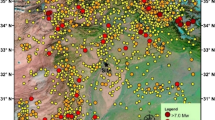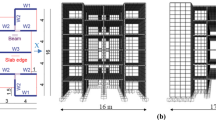Abstract
Blast induced vibrations form an inevitable and major part of modern day construction. The changes that happen to the strata or buildings surrounding the blast are evident in a fraction of a second. Effect of damage is more pronounced in the absence/presence of the tunnel. The vibration produced due to blast may be induced due to a deep underground explosion, a surface explosion or even an in-tunnel explosion. In this study the above three situations are numerically modeled by a Distinct Element software 3DEC (3.0). Soil properties are varied representing soft and stiff strata. Further, three velocity time histories of 2, 45 and 85 Hz are used as an input in the model and are applied at three different boundaries of the model. Results of the analysis reveal that the response of building in softer strata and lower frequencies led to greater magnification of velocities and displacements compared to response of buildings in stiff strata. Presence of the tunnel led to reduction of peak velocity (PV’s) and displacements at the building top due to damping effect. PV’s at the top floor were greater than the PV’s at the bottom floor and there was an upliftment of the soil mass at the ground level. However, the upliftment in the presence of the building was lower than the upliftment in the absence of the building. Stress in the tunnel lining increased in the presence of the building, however percentage reduction of stress depends on the number of building stories.












Similar content being viewed by others
References
Dowding CH, Rozen A (1978) Damage to rock tunnel from earthquake shaking. J Geotech Eng Div ASCE 104(GT2):175–191
Dowding CH, Beck WK, Atmatzidis DK (1980) Blast vibration implications of cyclic shear behavior of model plaster panels. ASTM Geotech Test J 3(2):81–90
Edwards AT, Northwood TD (1960) Experimental studies of the effect of blasting on structures. Eng Lond 210(5662):539–546
Hashash YA, Hook JJ, Schmidt B, Yao JIC (2001) Seismic design and analysis of underground structures. Tunn Undergr Space Technol 16:247–293
Jiang N, Zhou C (2012) Blasting vibration safety criterion for a tunnel liner structure. Tunn Undergr Space Technol 32:52–57
John St CM, Zahrah TF (1987) A seismic design of underground structures. Tunn Undergr Space Technol 2:165–197
Kulhawy FH (1975) Stress deformation properties of rock and rock discontinuities. Eng Geol 9:327–350
Liu H (2009) Dynamic analysis of subway structures under blast loading. Geotech Geol Eng 27:699–711
Liu H, Song E (2005) Seismic response of large underground structures in liquefiable soils subjected to horizontal and vertical earthquake excitations. Comput Geotech 32:223–244
Lysmer J, Kuhlemeyer R (1969) Finite dynamic model for infinite media. J Eng Mech Div ASCE 95(4):859–877
Ma G, Zhou H, Karen C (2011) In-structure shock assessment of underground structures with consideration of rigid body motion. J Eng Mech ASCE 137:797–806
Nicholls HR, Johnson CF, Duvall WI (1971) Blasting vibrations and their effect on structures. Bureau of Mines, Bulletin 656, Washington
Odello RJ (1976) Ground shock effects from accidental explosions. Technical memorandum No.TM M-51-76-22, Department of the U.S. Army Picatinny Arsenal
Singh PK, Roy MP (2010) Damage to surface structures due to blast vibration. Int J Rock Mech Min Sci 47:949–961
Tian L, Li Z (2008) Dynamic response analysis of a building structure subjected to ground shock from a tunnel explosion. Int J Impact Eng 35:1164–1178
Wang WL, Wang TT, Su JJ, Lin CH, Seng CR, Huang TH (2001) Assessment of damage in mountain tunnels due to the Taiwan Chi-Chi earthquake. Tunn Undergr Space Technol 16:133–150
Wei H, Jian-Yun Chen, Jing Guo (2011) Dynamic analysis of subway station subjected to internal blast loading. J Cent South Univ Technol 18:917–924
Author information
Authors and Affiliations
Corresponding author
Appendix
Appendix
Code for developing frequencies
load Filename.txt
velocity = Filename (:,2);
time = Filename(:,1);
plot(abs(fft(Filename(:,2))))
xlim([0,120])
Rights and permissions
About this article
Cite this article
Rebello, N.E., Shivashankar, R. & Sastry, V.R. Response of Strata and Buildings to Blast Induced Vibrations in the Presence and Absence of a Tunnel. Geotech Geol Eng 34, 1013–1028 (2016). https://doi.org/10.1007/s10706-016-0021-y
Received:
Accepted:
Published:
Issue Date:
DOI: https://doi.org/10.1007/s10706-016-0021-y




